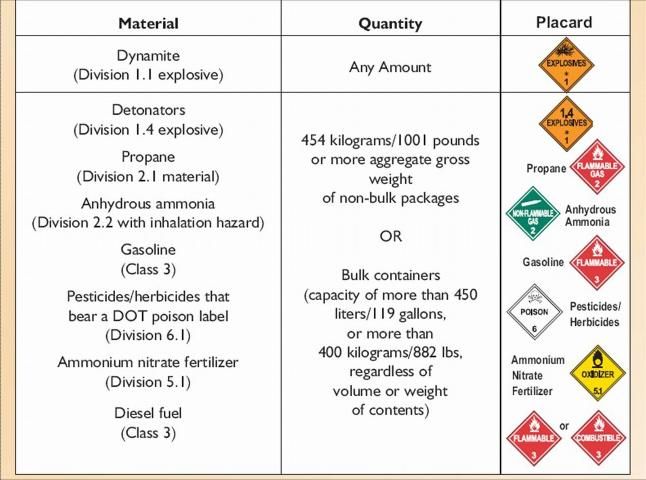This EDIS document addresses the concern for transporting pesticides that are regarded as hazardous materials by the Secretary of Transportation. This document is specifically written to provide information for those who are considered farmers by the Hazardous Materials Regulations (HMR). These regulations are the rules to follow if you ship or transport a hazardous material in the course of your business. A similar EDIS document also exists that addresses the transport of hazardous materials by pest control businesses, which can be found at https://edis.ifas.ufl.edu/pi198.
Introduction
Some materials, including pesticides, are considered to be hazardous materials by the US Department of Transportation (DOT). Transporting any hazardous material can be risky, so regulations have been established to protect employees who transport materials as well as nearby people and the environment.
Farmers, Agricultural Product, and the HMR
A farmer, according to the HMR, is a person who is engaged in the production or raising of crops, poultry, or livestock.
Many products used in this industry, including fertilizers, pesticides, soil amendments, and fuels, are identified by their hazard class (Table 1).
Transporting Between Fields
If you are a farmer transporting agricultural products—other than gases—between fields of the same farm using local roads, you are exempt from the HMR. The same farm can mean any property that you own, lease, or rent. If you transport a Class 2 hazardous material between fields, then you fall under the HMR. In this event, your dealer/co-op will supply you with the proper product shipping paper and placards for your vehicle when you make the purchase.
Transporting to or from the Farm
Likewise, farmers are subjected to the HMR when transporting products classified as hazardous materials from the dealer/co-op to their farm. Farmers are exempt from the requirements for emergency response information, training, and specific packaging as identified in the HMR when:
-
Transporting materials within the state;
-
Transporting materials within 150 miles of the farm;
-
The total weight of the hazardous material transported on a single vehicle does not exceed 16,094 pounds of ammonium nitrate fertilizer properly classed as Division 5.1, PG III, in bulk packaging; 502 gallons for liquids or gases; and 5,070 pounds for solids of any other agricultural product.
If your dealer/co-op delivers regulated products to your farm, it is their responsibility to abide by the HMR.
Using Placards to Communicate Hazards
Placards required by the HMR provide emergency response personnel a quick way to assess the hazards associated with the material that is being transported. Figure 1 shows some examples of types and quantities of hazardous materials that require a placard.

Transportation Security Requirements for Production Agricultural Operations
Since 2003, agricultural producers who ship or transport hazardous materials in quantities that require placards, as shown in Figure 1, must develop and implement a transportation security plan. Farmers who answer yes to any of the following questions need a security plan as well:
-
Do you make $500,000 or more annually in gross receipts from sale of agricultural commodities and products?
-
Do you transport hazardous materials not in direct support of your farming operation?
-
Do you transport hazardous materials by highway or rail outside a 150 mile radius of your farming operations?
The goal of this requirement is to deter terrorists and other illegal acts and also limit a producer's exposure to liability in the event that an illegal act occurs. The plan must include measures to address personnel, unauthorized access, and en route transportation issues.
-
Personnel Security. If you use employees to pick up and transport placarded hazardous materials from your dealer/co-op to your farm, then your security plan must include measures to confirm information provided by the employee on his/her job application or resume. This requirement only applies to employees hired after September 25, 2003, who are involved in the actual shipment or transportation of the materials covered by the plan.
-
Unauthorized Access. Your security plan must include measures to protect against unauthorized access by using locks and/or physical or visual observation. For example, if you stop on the way back to your farm, you should keep your vehicle in sight and/or lock or secure the material in the vehicle.
-
En Route Security. Your plan must include measures to ensure the security of the materials between the time you pick them up and the time you arrive at your farm. In this case, the most effective security measure would be to minimize the time the shipment is in transit by going directly from your supplier to your farm.
Your plan can be tailored to your operation. It will not be collected by or kept on file at state or federal DOT offices. Your plan will be enforced by state or federal DOT officials as part of the general enforcement program for the hazardous materials carrier and shipper community but not as part of any roadside stop inspections. An example of a hazardous materials transportation security plan for agricultural operations is shown in Table 2.
Additional Information
Chemtrec. (CHEMical TRansportation Emergency Center). 1-800-262-8200. http://www.chemtrec.org/Chemtrec
Fishel, F.M. 2005. Understanding Safety Data Sheet Language. Gainesville: University of Florida Institute of Food and Agricultural Sciences. https://edis.ifas.ufl.edu/pi072
Florida Department of Transportation. 866-374-FDOT (3368). http://www.dot.state.fl.us
Nesheim, O.N. and F.M. Fishel. 2005. Proper Disposal of Pesticide Waste. Gainesville: University of Florida Institute of Food and Agricultural Sciences. https://edis.ifas.ufl.edu/pi010
United States Department of Transportation. 202-366-4000. http://www.dot.gov